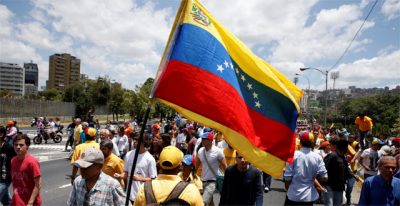Large-scale Manoeuvres Encircling Venezuela

On 11 August 2017, the U.S. President, Donald Trump put on the table the option of taking military action against Venezuela. As Manlio Dinucci substantiates in this article, President Trump was not plucking words out of the air. The Mobility Guardian drill has just taken place in the United States, with the armies of 25 states participating and another 12 states observing. This was a repeat exercise for a prompt transport of forces of an enlarged Nato to the conflict zone.
The political media reflectors shine their spotlight on what is happening within Venezuela yet leave a shadow cast over what is happening around Venezuela. As the Pentagon has plotted out the world, Venezuela falls under the jurisdiction of the U.S. Southern Command (Southcom). This is one of U.S.A.’s six “unified fighter commands”. The US has sliced the world up into six and given a slice to each of these commands, as their domain of responsibility.
So Southcom’s slice means that it is responsible for the 31 countries and 16 territories that form Latin America and the Caribbean. To police this area, SouthCom has land, naval and air forces as well as a marine corps. It also has special forces and the following three specific task forces:
- The Joint Task Force Bravo: stationed in the air base of Soto Cano, Honduras, it is organizing multilateral drills and other operations;
- The Joint Task Force Guantanamo: stationed at the naval base bearing the same name in Cuba, this carries out “operations of detention and interrogation in the context of the war against terrorism”; and
- The Joint Interagency Task Force South: stationed at Key West, Florida, the official task of which is to coordinate “anti-drug operations” across the whole region.
The ratcheting of SouthCom’s activity makes it clear to us that when President Trump declared on 11 August that “We have many options for Venezuela, including possibly a military option” – this was is no idle threat.
Last June, a special force of marines equipped with military helicopters was stationed in Honduras for regional operations meant to last for six months. Still under the remit of Southcom, the Tradewinds drill was carried out with forces from 20 countries of the Americas and the Caribbean participating. In July, a Unitas naval operation took place in Peru, with 18 countries participating; while Paraguay was the locus for the competition – a drill of special forces from 20 countries. From 25 July to 4 August, hundreds of officials from 20 countries have taken part in Panamax, a drill officially designed to “defend the Panama Canal”.
From 31 July to 12 August, at Joint Base Lewis–McChord (Washington), Mobility Guardian took place. This was the “biggest and most realistic drill for air mobility”. In it participated 3,000 men and 25 international partners, notably the Colombian and Brazilian air forces which were trained in day time and night time missions together with US, French and British air forces.
The “realistic scenario” involves a large-scale air operation to swiftly transport forces and arms to the zone of intervention. This is therefore proof of the military intervention in Venezuela, threatened by Trump.
The main base for this operation would be Venezuela’s neighbour, Colombia. The latter was hooked up to Nato in 2013 through a partnership agreement. “The Colombian military personnel – reports Nato – has taken part in a number of courses at the Nato academy in Oberammergau (Germany) and at the Nato Defense College at Rome, as well as participating in many high level military conferences”.
That a plan for military intervention in Venezuela in in place is confirmed by the Admiral Kurt Tidd, the Southcom Commander: at a Senate Hearing on 6 April 2017, he declared that the “escalating humanitarian crisis in Venezuela could require a regional response”.
To make good on the “military option” threatened by Trump, the same strategy actioned in Libya and Syria could be adopted, although the context would be somewhat different. What is envisaged is the infiltration of special forces and mercenaries who, with petrol, inflame Venezuela’s raw nerves, where social tensions have accumulated: an exercise to provoke armed confrontations. Then the government could be charged with massacring its own people which would open the door for “humanitarian intervention” by a coalition, with the U.S.A., the leader of the pack.
Translated from Italian to English by Anoosha Boralessa
Featured image is from Land Destroyer Report.

